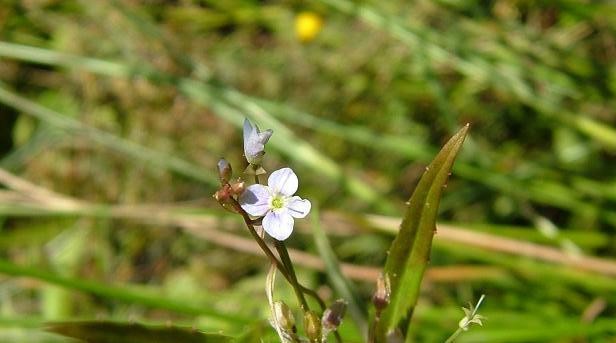Marsh speedwell
(Veronica scutellata)

Description
Veronica scutellata is a species of flowering plant in the plantain family known by the common names marsh speedwell, skullcap speedwell, and grassleaf speedwell. It is native to temperate Asia, Europe, northern Africa, and northern North America, including most of Canada and the northern half of the United States. It occurs in moist and wet habitats, such as ponds, marshes and other wetlands. It is a rhizomatous herbaceous perennial producing a decumbent or upright stem 40–60 cm (16–24 in) in maximum height. It is mostly hairless in texture. The purple-green or reddish leaves are oppositely arranged in pairs about the stem, the blades lance-shaped and smooth-edged. The inflorescence is an open array of several flowers on thin, straight pedicels. The flower is up to 1 cm (0.39 in) wide with four lobes, the upper lobe being largest. It is white, blue, or purplish with purple veining. It yields a flat, notched capsule a few millimeters wide. Veronica is the largest genus in the flowering plant family Plantaginaceae, with about 500 species; it was formerly classified in the family Scrophulariaceae. Common names include speedwell, bird's eye, and gypsyweed. Taxonomy for this genus is currently being reanalysed, with the genus Hebe and the related Australasian genera Derwentia, Detzneria, Chionohebe, Heliohebe, Leonohebe and Parahebe now included by many botanists. Monophyly of the genus is supported by nuclear ribosomal internal transcribed spacer (ITS) and cpDNA. The taxa of the genus are herbaceous annuals or perennials, and also subshrubs, shrubs or small trees if Hebe is included. Most of the species are from the temperate Northern Hemisphere, though with some species from the Southern Hemisphere; Hebe is mostly from New Zealand. The genus name Veronica used in binomial nomenclature was chosen by Carl Linnaeus based on preexisting common usage of the name veronica in many European languages for plants in this group. Such use in English is attested as early as 1572. The name probably reflects a connection with Saint Veronica, whose Latin name is ultimately derived from Greek, Berenice. Veronica americana is edible and nutritious, as are most species in the genus Veronica, and is reported to have a flavor similar to watercress. Native Americans used Veronica species as an expectorant tea to alleviate bronchial congestion associated with asthma and allergies. The plant can be confused with skullcap and other members of the mint family.
Taxonomic tree:







